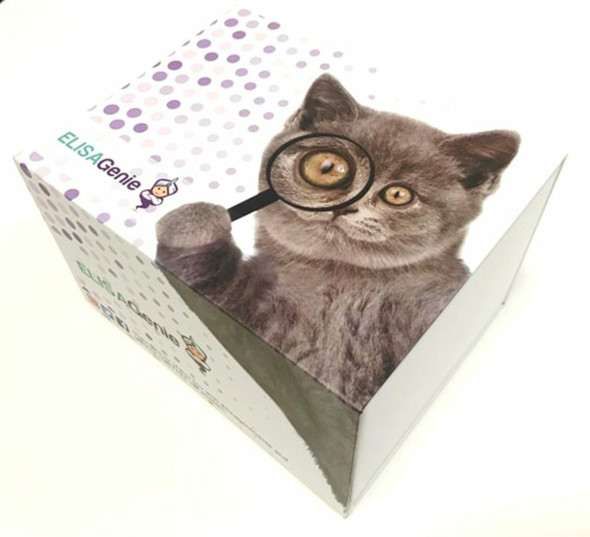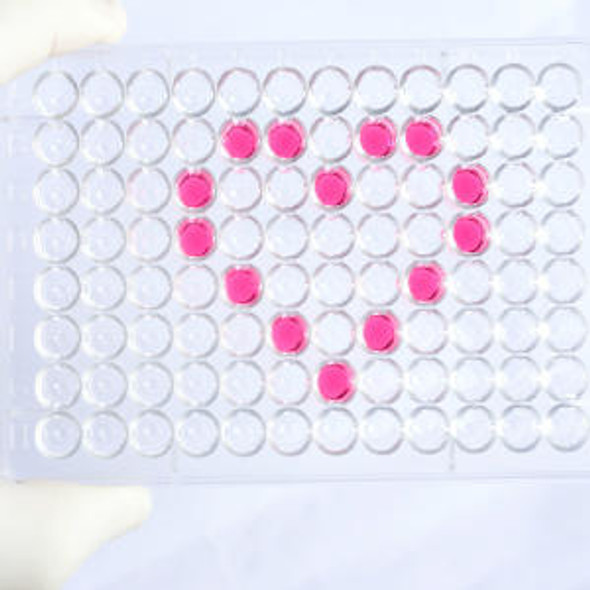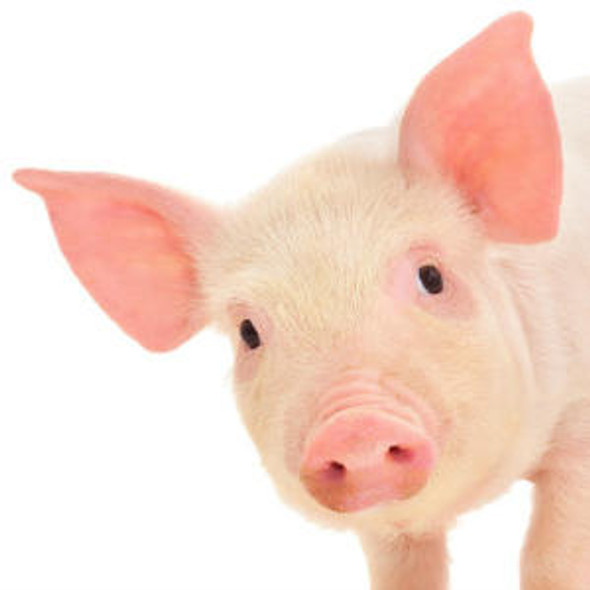Human Cell Biology ELISA Kits 6
Human IGF1R (Insulin Like Growth Factor 1 Receptor) ELISA Kit (HUES01638)
- SKU:
- HUES01638
- Product Type:
- ELISA Kit
- Size:
- 96 Assays
- Uniprot:
- P08069
- Sensitivity:
- 0.19ng/mL
- Range:
- 0.31-20ng/mL
- ELISA Type:
- Sandwich
- Synonyms:
- CD221, IGFIR, IGFR, JTK13
- Reactivity:
- Human
- Sample Type:
- Serum, plasma and other biological fluids
- Research Area:
- Cell Biology
Description
| Assay type: | Sandwich |
| Format: | 96T |
| Assay time: | 4.5h |
| Reactivity: | Human |
| Detection Method: | Colormetric |
| Detection Range: | 0.31-20 ng/mL |
| Sensitivity: | 0.19 ng/mL |
| Sample Volume Required Per Well: | 100µL |
| Sample Type: | Serum, plasma and other biological fluids |
| Specificity: | This kit recognizes Human IGF1R in samples. No significant cross-reactivity or interference between Human IGF1R and analogues was observed. |
This ELISA kit uses Sandwich-ELISA as the method. The micro ELISA plate provided in this kit has been pre-coated with an antibody specific to Human IGF1R. Standards or samples are added to the appropriate micro ELISA plate wells and combined with the specific antibody. Then a biotinylated detection antibody specific for Human IGF1R and Avidin-Horseradish Peroxidase (HRP) conjugate are added to each micro plate well successively and incubated. Free components are washed away. The substrate solution is added to each well. Only those wells that contain Human IGF1R, biotinylated detection antibody and Avidin-HRP conjugate will appear blue in color. The enzyme-substrate reaction is terminated by adding Stop Solution and the color turns yellow. The optical density (OD) is measured spectrophotometrically at a wavelength of 450 nm ± 2 nm. The OD value is proportional to the concentration of Human IGF1R. The concentration of Human IGF1R in samples can be calculated by comparing the OD of the samples to the standard curve.
| UniProt Protein Function: | IGF1R: a receptor tyrosine kinase that binds insulin-like growth factor 1 (IGF1) with a high affinity and IGF2 with a lower affinity. Functions as an anti-apoptotic agent by enhancing cell survival. Can play a critical role in transformation events. Cleavage of the precursor generates alpha and beta subunits. Tetramer of 2 alpha and 2 beta chains linked by disulfide bonds. The alpha chains contribute to the formation of the ligand- binding domain, while the beta chain carries the kinase domain. Interacts with PIK3R1 and with the PTB/PID domains of IRS1 and SHC1 in vitro when autophosphorylated on tyrosine residues. Mutated in rare cases of pre- and post-natal growth retardation. One SNP associated with increased human longevity. Increased expression of IGF1R and other pathway members associated with progression and malignancy in a range of cancers. Inhibitors: AG1024, AEW541. |
| UniProt Protein Details: | Protein type:Protein kinase, tyrosine (receptor); Protein kinase, TK; Kinase, protein; Membrane protein, integral; EC 2. 7. 10. 1; TK group; InsR family Chromosomal Location of Human Ortholog: 15q26. 3 Cellular Component: integral to plasma membrane; intracellular membrane-bound organelle; membrane; plasma membrane; receptor complex Molecular Function:ATP binding; identical protein binding; insulin binding; insulin receptor binding; insulin receptor substrate binding; insulin-like growth factor binding; insulin-like growth factor I binding; insulin-like growth factor receptor activity; phosphoinositide 3-kinase binding; protein binding; protein-tyrosine kinase activity Biological Process: brain development; epidermis development; exocrine pancreas development; immune response; inactivation of MAPKK activity; insulin receptor signaling pathway; insulin-like growth factor receptor signaling pathway; male sex determination; mammary gland development; negative regulation of apoptosis; negative regulation of protein kinase B signaling cascade; negative regulation of transcription factor activity; phosphoinositide 3-kinase cascade; phosphoinositide-mediated signaling; positive regulation of cell migration; positive regulation of cell proliferation; positive regulation of DNA replication; positive regulation of MAPKKK cascade; positive regulation of mitosis; positive regulation of protein kinase B signaling cascade; protein amino acid autophosphorylation; protein tetramerization; regulation of JNK cascade; signal transduction Disease: Insulin-like Growth Factor I, Resistance To |
| NCBI Summary: | This receptor binds insulin-like growth factor with a high affinity. It has tyrosine kinase activity. The insulin-like growth factor I receptor plays a critical role in transformation events. Cleavage of the precursor generates alpha and beta subunits. It is highly overexpressed in most malignant tissues where it functions as an anti-apoptotic agent by enhancing cell survival. Alternatively spliced transcript variants encoding distinct isoforms have been found for this gene. [provided by RefSeq, May 2014] |
| UniProt Code: | P08069 |
| NCBI GenInfo Identifier: | 124240 |
| NCBI Gene ID: | 3480 |
| NCBI Accession: | P08069. 1 |
| UniProt Secondary Accession: | P08069,Q14CV2, Q9UCC0, B1B5Y2, |
| UniProt Related Accession: | P08069 |
| Molecular Weight: | |
| NCBI Full Name: | Insulin-like growth factor 1 receptor |
| NCBI Synonym Full Names: | insulin like growth factor 1 receptor |
| NCBI Official Symbol: | IGF1R |
| NCBI Official Synonym Symbols: | IGFR; CD221; IGFIR; JTK13 |
| NCBI Protein Information: | insulin-like growth factor 1 receptor |
| UniProt Protein Name: | Insulin-like growth factor 1 receptor |
| UniProt Synonym Protein Names: | Insulin-like growth factor I receptor; IGF-I receptor |
| Protein Family: | Insulin-like growth factor 1 receptor |
| UniProt Gene Name: | IGF1R |
| UniProt Entry Name: | IGF1R_HUMAN |
As the OD values of the standard curve may vary according to the conditions of the actual assay performance (e. g. operator, pipetting technique, washing technique or temperature effects), the operator should establish a standard curve for each test. Typical standard curve and data is provided below for reference only.
| Concentration (ng/mL) | O.D | Average | Corrected |
| 20 | 2.378 2.422 | 2.4 | 2.311 |
| 10 | 1.627 1.661 | 1.644 | 1.555 |
| 5 | 0.981 0.959 | 0.97 | 0.881 |
| 2.5 | 0.455 0.479 | 0.467 | 0.378 |
| 1.25 | 0.278 0.256 | 0.267 | 0.178 |
| 0.63 | 0.195 0.179 | 0.187 | 0.098 |
| 0.31 | 0.133 0.145 | 0.139 | 0.05 |
| 0 | 0.087 0.091 | 0.089 | -- |
Precision
Intra-assay Precision (Precision within an assay): 3 samples with low, mid range and high level Human IGF1R were tested 20 times on one plate, respectively.
Inter-assay Precision (Precision between assays): 3 samples with low, mid range and high level Human IGF1R were tested on 3 different plates, 20 replicates in each plate.
| Intra-assay Precision | Inter-assay Precision | |||||
| Sample | 1 | 2 | 3 | 1 | 2 | 3 |
| n | 20 | 20 | 20 | 20 | 20 | 20 |
| Mean (ng/mL) | 1.05 | 2.62 | 9.14 | 1.03 | 2.42 | 9.30 |
| Standard deviation | 0.05 | 0.12 | 0.30 | 0.06 | 0.11 | 0.36 |
| C V (%) | 4.76 | 4.58 | 3.28 | 5.83 | 4.55 | 3.87 |
Recovery
The recovery of Human IGF1R spiked at three different levels in samples throughout the range of the assay was evaluated in various matrices.
| Sample Type | Range (%) | Average Recovery (%) |
| Serum (n=5) | 96-107 | 101 |
| EDTA plasma (n=5) | 96-111 | 101 |
| Cell culture media (n=5) | 92-108 | 99 |
Linearity
Samples were spiked with high concentrations of Human IGF1R and diluted with Reference Standard & Sample Diluent to produce samples with values within the range of the assay.
| Serum (n=5) | EDTA plasma (n=5) | Cell culture media (n=5) | ||
| 1:2 | Range (%) | 94-110 | 83-96 | 92-106 |
| Average (%) | 101 | 90 | 98 | |
| 1:4 | Range (%) | 85-101 | 87-100 | 89-101 |
| Average (%) | 92 | 92 | 94 | |
| 1:8 | Range (%) | 89-102 | 85-95 | 82-92 |
| Average (%) | 96 | 90 | 87 | |
| 1:16 | Range (%) | 87-98 | 81-92 | 86-99 |
| Average (%) | 93 | 85 | 91 |
An unopened kit can be stored at 4°C for 1 month. If the kit is not used within 1 month, store the items separately according to the following conditions once the kit is received.
| Item | Specifications | Storage |
| Micro ELISA Plate(Dismountable) | 8 wells ×12 strips | -20°C, 6 months |
| Reference Standard | 2 vials | |
| Concentrated Biotinylated Detection Ab (100×) | 1 vial, 120 µL | |
| Concentrated HRP Conjugate (100×) | 1 vial, 120 µL | -20°C(shading light), 6 months |
| Reference Standard & Sample Diluent | 1 vial, 20 mL | 4°C, 6 months |
| Biotinylated Detection Ab Diluent | 1 vial, 14 mL | |
| HRP Conjugate Diluent | 1 vial, 14 mL | |
| Concentrated Wash Buffer (25×) | 1 vial, 30 mL | |
| Substrate Reagent | 1 vial, 10 mL | 4°C(shading light) |
| Stop Solution | 1 vial, 10 mL | 4°C |
| Plate Sealer | 5 pieces | |
| Product Description | 1 copy | |
| Certificate of Analysis | 1 copy |
- Set standard, test sample and control (zero) wells on the pre-coated plate and record theirpositions. It is recommended to measure each standard and sample in duplicate. Note: addall solutions to the bottom of the plate wells while avoiding contact with the well walls. Ensuresolutions do not foam when adding to the wells.
- Aliquot 100 µL of standard solutions into the standard wells.
- Add 100 µL of Sample / Standard dilution buffer into the control (zero) well.
- Add 100 µL of properly diluted sample (serum, plasma, tissue homogenates and otherbiological fluids) into test sample wells.
- Cover the plate with the sealer provided in the kit and incubate for 90 min at 37 °C.
- Aspirate the liquid from each well, do not wash. Immediately add 100 µL of BiotinylatedDetection Ab working solution to each well. Cover the plate with a plate seal and gently mix. Incubate for 1 hour at 37 °C.
- Aspirate or decant the solution from the plate and add 350 µL of wash buffer to each welland incubate for 1-2 minutes at room temperature. Aspirate the solution from each well andclap the plate on absorbent filter paper to dry. Repeat this process 3 times. Note: a microplatewasher can be used in this step and other wash steps.
- Add 100 µL of HRP Conjugate working solution to each well. Cover with a plate seal andincubate for 30 min at 37 °C.
- Aspirate or decant the solution from each well. Repeat the wash process for five times asconducted in step 7.
- Add 90 µL of Substrate Reagent to each well. Cover with a new plate seal and incubate forapproximately 15 min at 37 °C. Protect the plate from light. Note: the reaction time can beshortened or extended according to the actual color change, but not by more than 30min.
- Add 50 µL of Stop Solution to each well. Note: Adding the stop solution should be done inthe same order as the substrate solution.
- Determine the optical density (OD value) of each well immediately with a microplate readerset at 450 nm.






